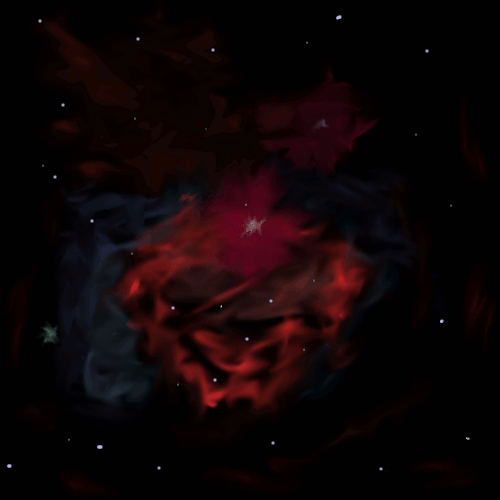

Nebulas are clouds of dust and gas made of atoms and molecules. Stars around them make them visible but they also radiate radio waves and infrared light. They are not only visible through telescopes, some like the Orion nebula,a bright emission nebula, can be seen with the naked eye.
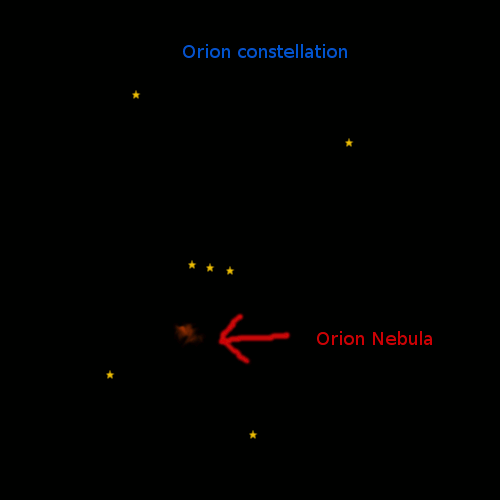
There are two kinds of nebulas:
If the nebula is near a hot star, it absorbs energy and this makes it glow a fluorescent red light. The electrons of atoms in the nebula jump up energy levels and after a while they jump back down and release the energy they absorbed by emitting a photon. The color of the light emitted varies from element to element because the distance between the energy levels is different for each element. Hydrogen is the most abundant element in nebulas and it emits red light when its electrons jump up and down energy levels so the nebula shines red.
This kind of nebula can be seen for great distances.
They are visible because star light reflects from tiny dust grains in the nebula. These clouds of dust and gas shine mostly blue because this color reflects particularly well of abundant atoms in the nebula like carbon. These atoms are very small and are too small for long wavelengths like red light, but just the right size for shorter blue wavelengths.
When there is a shock wave that comes from a supernova(explosion of a star) or the collision of two black holes, the dust and gas in the nebula starts clumping together. Through gravity stars and planets are formed.
The cloud of dust and gas needs to be cold because if it is too hot there is to much energy counteracting gravity, which is needed to collapse the dust and gas to form a star. Ones the star is formed it can get very hot without problem because then the atoms are close enough together so that gravity can stop them from escaping.
Most of a stars life is in this stage. As you can see in the Hertzsprung Russel diagram most stars are main sequence stars.
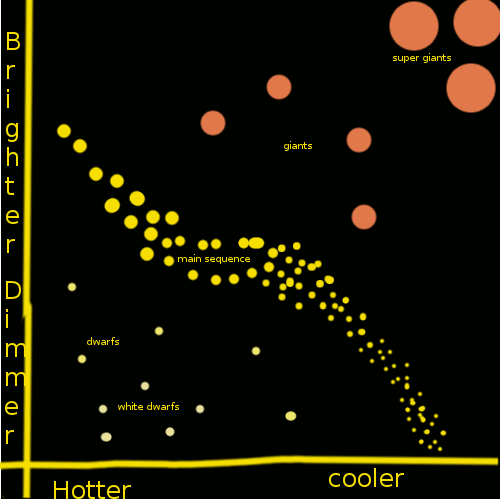
90% of a stars life it will fuse hydrogen into helium by using the proton proton chain.
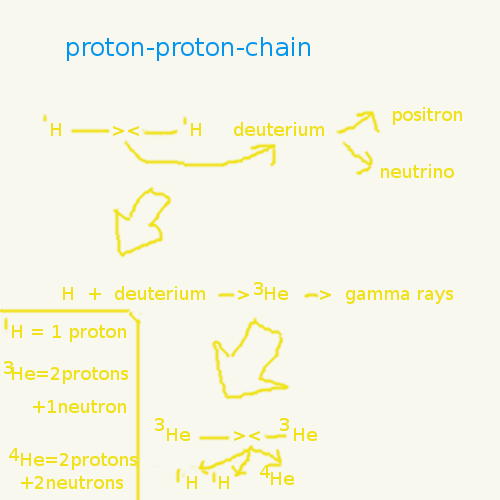
After 90% of a stars life the core runs out of hydrogen. So there is no more energy source. Depending on how big the star is it runs out of fuel faster or slower. Big stars run out very quickly because the energy from the fusion must balance the force of gravity so that the star does not fall into itself. The bigger the star the more energy is needed to counter act gravity.
So as there is no more energy the star collapses making enough energy to burn (fuse atoms from the same element into something else) helium. This heats up the outer layers making it possible to fuse hydrogen. The hydrogen burning in the outer layers heats these layers up even more making them expand. expansion makes things cool down so the star turns from a yellow main sequence star to a red giant.
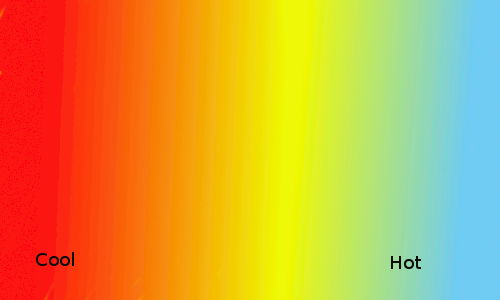
Helium burning is also called the Triple Alpha process because alpha particles are Helium cores with out electrons.
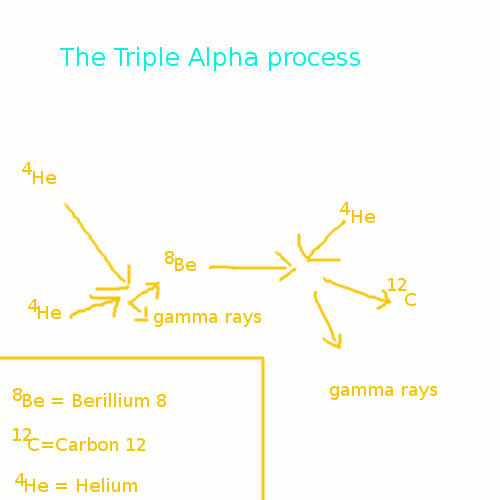
When the core runs out of helium it falls into itself again. This makes enough heat(energy) to burn the carbon from the helium burning.
Now there are two possibilitys:
Through time the helium layer gets thermicly unstable. It heats up because of the carbon fussing core making more helium burning and with that more energy to expand. Because the hydrogen layer is on top of the helium layer it gets some of its energy and expands too. When the hydrogen layer expands there is less pressure and with that not enough energy to burn hydrogen anymore. So the hydrogen layer false back into its self and into part of the helium layer which contains carbon and oxygen needed for the CNO cycle. so the hydrogen layer does not use the proton proton chain anymore but the CNO cycle.
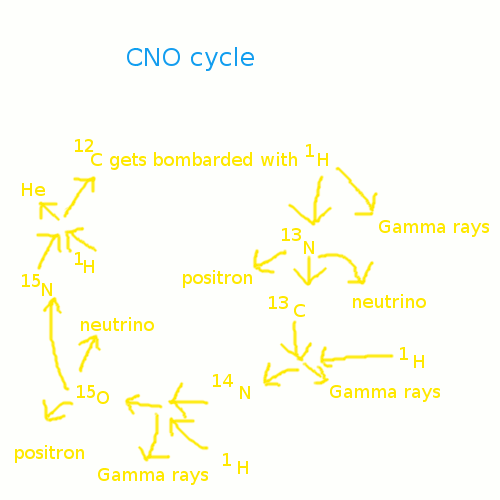
The expansion and collapse of the hydrogen layer is called a pulse and happens regularly in old stars.
In the CNO cycle, nitrogen gets produced which during the next pulse gets mixed into the helium layer. There it gets fused into fluorine 18 --> oxygen 18 --> neon 22 and in stars with enough mass neon 22 gets fused to magnesium 25
When this process is finished and the carbon in the core is used up the star does not have enough mass to contract and fuse new things. So it depends on its helium and hydrogen layers witch make more and more pulses as they come closer to the surface.
It is the end of the stars life. The outer layers are so far out from the expanding of the star that they are no longer held back by gravity. The star lets go of its outer layers, leaving a white dwarf.
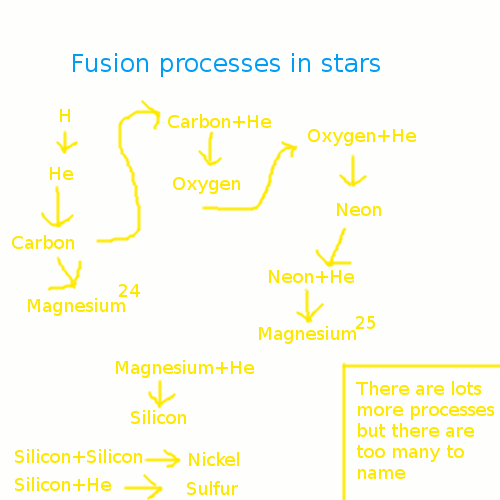
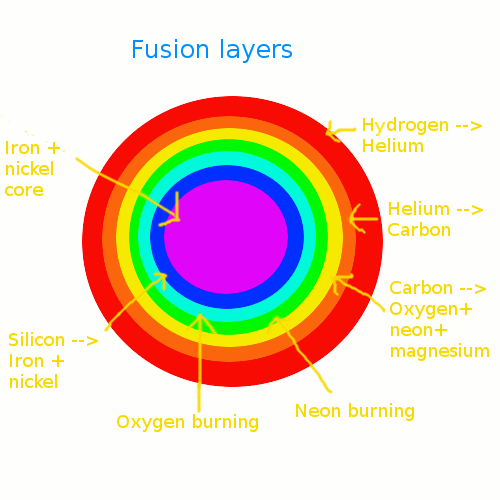
When carbon fuses into neon neutrinos get emitted. Neutrinos escape the star much more easily and rapidly then photons(light). Before the photons (the energy pushing out) was balanced with gravity. Now the energy from the fusion gets mostly transformed into neutrinos which escape the star to rapidly to do much outward push. Even so a lot of photons still get produced the star loses energy and collapses making heat. With this extra heat there is more fusion making more neutrinos.
This process also happens in smaller stars but as it does not have enough mass to contract and make the heat necessary for more fusion it will slowly fall into itself and push of its outer layers.
In very massive stars this process gets worth and worth as it fuses neon and oxygen and makes the stars life shorter and shorter. Silicon burning only takes one day.
When the star has an iron and nickel core it can't contract enough to make something new so like the less massive stars its core collapses and it loses its outer layers but because there is more energy involved, it collapses until it can't collapse further and eventually the star explodes into a supernova and leaves behind a neutron star. If the star has more then 20 solar masses it becomes a black hole.
The process stops at iron because iron nicely balances the strong nuclear force (which holds the atom together) and the electromagnetic force(which pulls it apart(the protons which all have the same charge repel each other)). All elements try to be like iron. Elements heavier than iron emit energy when they fall apart because they have excess electromagnetic force. Elements lighter than iron emit energy when fused together because they have excess strong nuclear force. Since Iron is in the middle(nicely balanced) it does not emit energy when split apart or if 2 iron atoms where fused together. A few elements around iron in the periodic table like nickel are also very stable.
Copyright © 2018 Jessica Socher ()